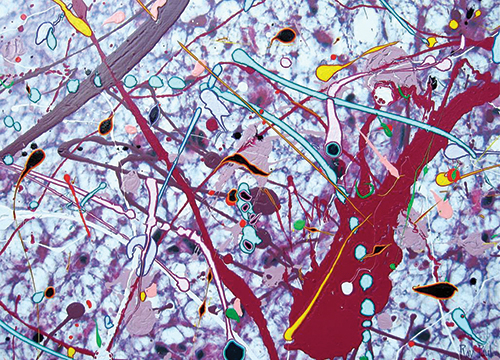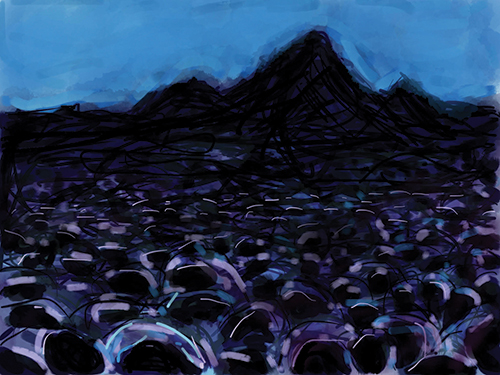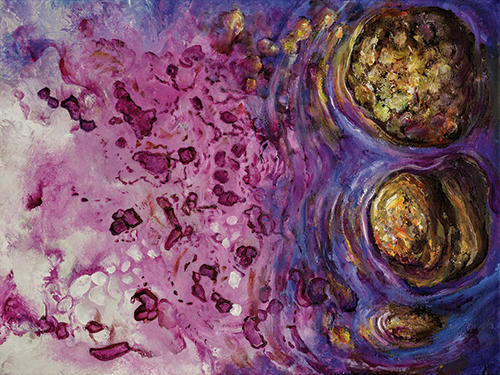Anne Ford
September 2016—When Ray Paul was diagnosed with sarcoma in 2011, he wanted to understand his disease. His neighbor was a resident in the radiation department at Moffitt Cancer Center, Tampa, Fla., where Paul was being treated, and that neighbor was happy to introduce him to the pathologist on Paul’s case.

Paul
An artist and biologist, Paul told the pathologist: “‘I want to see what my tumor looks like. I want to stare my devil in the eye,’” recalls Marilyn M. Bui, MD, PhD, a senior member of the Departments of Anatomic Pathology and Sarcoma, section head of bone and soft tissue pathology, and scientific director of the analytic microscopy core, Moffitt Cancer Center, and a professor and cytopathology fellowship director, University of South Florida Morsani College of Medicine.
Dr. Bui invited Paul to view his tumor cells with her through her double-headed microscope and sent him digital images as well. Paul enlarged those images, had them printed directly onto canvas, and painted over them to create striking works of art. “I attacked the images directly with paint, made something beautiful out of a terrible diagnosis, and showed there’s hope and strength in it,” he tells CAP TODAY.
Now the collaboration of Paul and Dr. Bui has inspired an entire book: The Healing Art of Pathology, a collection of artwork and essays derived from or inspired by pathology. Edited by Dr. Bui and Katherine A. Galagan, MD, and published by CAP Press, the volume contains a selection of Paul’s artwork and nearly 60 other pieces by pathologists, patients and their families, and other artists, among them laboratory scientists and technologists.
The book’s editors hope readers will not only enjoy the artistry but also feel a connection. “I wanted to create a book that would connect pathologists to patients, and pathologists to other medical professions,” Dr. Bui explains.
Her desire to do so predated her encounter with Paul. Even before then, as a relatively new member of the CAP Publications Committee, she had been contemplating ideas for volumes that would add new dimension to CAP Press’ usual fare of pathology textbooks.

One of three pieces of art in the book by Ray Paul, titled “My Sarcoma #2.” Acrylic, latex, and enamel on canvas printed with a photographic image of the metastatic sarcoma to his lung. “This piece is my attempt to face my cancer head-on through my artwork. I am throwing all of my paint, energy, and soul into this battle,” he writes.
“I felt we should publish some books that focus on the people behind the microscope, because I know how significant our jobs are for patient care, but we tend to be invisible physicians,” she says. “There is much to be done in terms of making connections to our patients and advocating for our profession, which ultimately means better patient care.” She hopes the inviting and accessible Healing Art book will open the world of pathology to patients and their families through art.
Once the concept for the book had been approved, Dr. Bui, Dr. Galagan (chair of the CAP Publications Committee), and CAP Press staff sought submissions from “whoever allowed us to spread the word,” Dr. Bui says. When all the artwork and essays had come in, the editors realized they now suffered from an embarrassment of riches: With so many high-quality images, the book would be too costly to produce.

“Cancer Landscapes” by James Saller, MD, a molecular pathology fellow at Moffitt Cancer Center. He writes: “Dr. Bert Vogelstein used the term cancer landscapes (Cancer genome landscapes. Science. 2013;339:1546) to describe events leading to cancer. He compares impactful driver mutations to mountains, and benign passenger mutations to flat plains. I want to offer an alternative interpretation of the landscape metaphor by imagining the surface of a tumor as akin to a panoramic landscape. Laypeople and pathologists alike have to rely principally on their imaginations to reconstruct how a tumor looks, translating flat slides and radiologic slices into three dimensions. I invite our imaginations to consider how complex a tumor is in reality.”
Says Dr. Galagan: “It just so happens that since I retired [as chief of pathology and director of clinical laboratories at Virginia Mason Medical Center, Seattle], I’ve learned how to use InDesign software, so I volunteered to do the initial layout and editing. That allowed us to keep the cost down so we could publish the book.” They then turned their work over to CAP Press editor Caryn Tursky for the final work.
Not all of the art in the book is visual. The volume also contains essays, such as “How Angiosarcoma and Facebook Changed My Life,” a moving work by Jerad M. Gardner, MD, an assistant professor of pathology and dermatology at the University of Arkansas for Medical Sciences. In his essay he describes how joining an angiosarcoma patient support group on Facebook changed him as a person and physician.
“It turns out that patients want to talk to pathologists, to hear what we do and why,” Dr. Gardner writes in the book. “Rather than seeking medical advice, I was surprised that most patients sought mostly to understand their disease. Their savvy queries even raised new questions in my own mind about a tumor that I had thought I understood so well. I wanted to educate patients, but they have taught me so much more than I have taught them. . . . In the end, it was not my expertise or knowledge that mattered. It was my willingness to raise awareness that brought ‘joy’ and ‘relief.’ This is healing, and any pathologist with humility and compassion can do this.”

“Pathology of Sunlit River Rocks” by Lizzy Rainey, radiologic technologist. Acrylic on canvas, photograph by Andrew Farmer. In this painting, with the guidance of Ken Fortress, MD, pathologist at St. Elizabeth Hospital, Lafayette, Ind., Rainey has “portrayed the ugliness of malignant ovarian tumors as glistening river rocks surrounded by gently flowing water. The water flowing from the rocks gradually transforms into the magenta color, painted to resemble a pathology slide of breast cancer.”
One of the book’s written works comes from Bennet I. Omalu, MD, MBA, MPH, the forensic pathologist, neuropathologist, and epidemiologist whose work in chronic traumatic encephalopathy research led to his portrayal by Will Smith in the 2015 movie Concussion. After hearing Dr. Omalu’s keynote speech at CAP ’15, Dr. Bui found his message to be perfectly in sync with the book. She sent an email to him and was delighted to get a prompt and enthusiastic response. Dr. Omalu’s brief essay emphasizes the pathologist’s call to serve “our common humanity.”
“We humbly serve our common humanity in the background in our laboratories,” he writes, “providing diagnoses to other physicians and patients, looking out for the good health and well-being of everyone.”
In another of the book’s essays, CAP immediate past president Gene N. Herbek, MD, writes: “It took courage to conceive, write, and produce this book; I am not aware of another work that brings patients and pathologists together in quite the same way.”
CAP president Richard C. Friedberg, MD, PhD, says in the foreword: “For many, works of art may capture feelings of frustration and agitation, introspection and serenity, or even a peculiar anger that arises as a sequel to sorrow.”
Among the visual works readers will find inside are Oonagh Devoy’s “Finnleigh,” a drawing of the artist’s daughter after surgery to remove a brain tumor. “It was a time of great intimacy, and sleep was near impossible,” Devoy writes. “It felt wrong to take photographs, but I needed a part of her, so I sat at her bedside and made a number of drawings.” Those drawings would be either a reminder of a journey or a memorial to her child.
“Thankfully the results returned benign and slow growing. Pathology had given us hope for the future,” Devoy writes.
Also in the book is “Alopecia areata,” a painting by Beth Israel Deaconess Medical Center/Harvard Medical School pathology resident Edward Fulton, MD, who says he was first inspired to paint by an H&E-stained slide of ileum. Published, too, are several works from the private collection of Stanley J. Robboy, MD, such as artist Penny Oliver’s “Female Reproductive Histopathology Triptych: Endometrial Hyperplasia, Clear Cell Adenocarcinoma, Malignant Struma Ovarii.”
Dr. Robboy, a past president of the CAP and a professor of pathology and obstetrics and gynecology at Duke University Medical Center, not only contributed but also perused the book and found himself particularly taken by the vividness of the palette used in the artwork pathologists created.
“People think of pathologists as shy and so on, but these were really strong colors,” he tells CAP TODAY. “And there are so many geometric patterns. That’s what a pathologist does—pattern recognition. There’s a really overwhelming feeling of that.”
Dr. Galagan and Dr. Bui would like to see the book placed in patient waiting rooms, in laboratories, and in the hands of those who may be inspired to study pathology or laboratory medicine. “It will be a tall order to place this book in the hands of policymakers,” Dr. Bui says, “to inspire change and increase the visibility of pathology as a profession.”
“As we go forward in pathology,” Dr. Galagan says, “we’re going to be asked to be a lot more broad-ranging in our skill set, and I think the more we can get out there and interface with patients or other groups so that they understand what we’re doing, the more we’ll be able to affect medicine in a favorable way.
“Hopefully this book helps to make some of those bridges between us and the emotional, artistic side of life.”
[hr]
Anne Ford is a writer in Evanston, Ill. Dr. Bui and Dr. Galagan will donate the royalties they earn from The Healing Art of Pathology to the CAP Foundation to benefit its many programs such as See, Test & Treat. Order at www.cap.org (PUB315) or call the CAP at 800-323-4040 option 1. For members, $40; for nonmembers, $50.